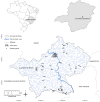Identification of Risk Areas for Intestinal Schistosomiasis, Based on Malacological and Environmental Data and on Reported Human Cases
- PMID: 34422845
- PMCID: PMC8377395
- DOI: 10.3389/fmed.2021.642348
Identification of Risk Areas for Intestinal Schistosomiasis, Based on Malacological and Environmental Data and on Reported Human Cases
Abstract
The aim of the present study was to use an integrated approach for the identification of risk areas for Schistosoma mansoni transmission in an area of low endemicity in Minas Gerais, Brazil. For that, areas of distribution of Biomphalaria glabrata were identified and were related to environmental variables and communities with reported schistosomiasis cases, in order to determine the risk of infection by spatial analyses with predictive models. The research was carried out in the municipality of Alvorada de Minas, with data obtained between the years 2017 and 2019 inclusive. The Google Earth Engine was used to obtain geo-climatic variables (temperature, precipitation, vegetation index and digital elevation model), R software to determine Pearson's correlation and MaxEnt software to obtain an ecological model. ArcGis Software was used to create maps with data spatialization and risk maps, using buffer models (diameters: 500, 1,000 and 1,500 m) and CoKriging. Throughout the municipality, 46 collection points were evaluated. Of these, 14 presented snails of the genus Biomphalaria. Molecular analyses identified the presence of different species of Biomphalaria, including B. glabrata. None of the snails eliminated S. mansoni cercariae. The distribution of B. glabrata was more abundant in areas of natural vegetation (forest and cerrado) and, for spatial analysis (Buffer), the main risk areas were identified especially in the main urban area and toward the northern and eastern extensions of the municipality. The distribution of snails correlated with temperature and precipitation, with the latter being the main variable for the ecological model. In addition, the integration of data from malacological surveys, environmental characterization, fecal contamination, and data from communities with confirmed human cases, revealed areas of potential risk for infection in the northern and eastern regions of the municipality. In the present study, information was integrated on epidemiological aspects, transmission and risk areas for schistosomiasis in a small, rural municipality with low endemicity. Such integrated methods have been proposed as important tools for the creation of schistosomiasis transmission risk maps, serve as an example for other communities and can be used for control actions by local health authorities, e.g., indicate priority sectors for sanitation measures.
Keywords: Biomphalaria; Schistosoma mansoni; ecological models; malacological survey; risk mapping.
Copyright © 2021 Coelho, Ker, Araújo, Guimarães, Negrão-Corrêa, Caldeira and Geiger.
Conflict of interest statement
The authors declare that the research was conducted in the absence of any commercial or financial relationships that could be construed as a potential conflict of interest.
Figures






References
-
- Lutz A. Caramujos de água doce do genero Planorbis, observados no Brasil. Mem Inst Oswaldo Cruz. (1918) 10:65–82. 10.1590/S0074-02761918000100004 - DOI
-
- Noya O, Katz N, Pontier JP, Theron A, Noya BA. Schistosomiasis in America. In: Franco-Paredes C, Santos-Preciado JI. editors. Neglected tropical diseases: Latin America and the Caribbean. Viena: Springer; (2015) p. 11–43. 10.1007/978-3-7091-1422-3_2 - DOI
-
- Katz N. Inquérito Nacional de Prevalência da Esquistossomose mansoni e Geo-helmintoses (2018). p. 76. Available online at: https://www.arca.fiocruz.br/bitstream/icict/25662/2/InquéritoNacionaldeP...
LinkOut - more resources
Full Text Sources

